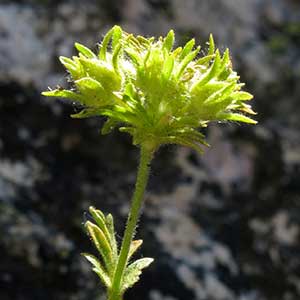Ivesia longibracteata
Ivesia aperta
Castle Crags ivesia, longbract mousetail
Sierra Valley ivesia, Sierra Valley mousetail
ascending to erect, 0.3–1.2 dm.
decumbent to erect, 1.5–4.5 dm.
weakly planar to loosely ± cylindric, (0.5–)2–4(–6) cm; sheathing base glandular abaxially, otherwise glabrous;
petiole 0.5–2 cm, hairs 0.2–1 mm;
leaflets 5–6 per side, 2–6 mm, ± short-hirsute, glandular-puberulent, lobes 2–7, oblanceolate to spatulate or obovate, apex not setose.
(7–)10–20(–23) cm; sheathing base densely strigose abaxially;
stipules absent;
petiole 4–8 cm, hairs abundant, ascending, ± 1(–3) mm;
leaflets 20–35 per side, loosely overlapping, 3–15(–20) mm, lobes 0–4(–5), oblanceolate to elliptic, hairs abundant, ascending to appressed, ± 1(–2) mm.
1–3, not paired.
3–8.
3–14-flowered, 1–2.5 cm diam.;
glomerules 1.
(10–)20–250-flowered, 1–14 cm diam., flowers arranged in several to many tight glomerules of 5–20 flowers.
1.5–6 mm.
1–3(–15) mm.
8–10 mm diam.;
epicalyx bractlets linear to narrowly lanceolate or elliptic, 2.5–5 mm, longer than sepals;
hypanthium shallowly cupulate, 0.5–1 × 2–3 mm;
sepals 1.5–2.5 mm, ± acute;
petals pale yellow, linear to narrowly oblanceolate, 1.5–2.5 mm;
stamens 5, filaments 0.7–1.3 mm, anthers yellow, 0.5–0.8 mm;
carpels 6–11, styles 1–1.5 mm.
5–12 mm diam.;
epicalyx bractlets lanceolate, 1.5–2.5(–3.5) mm;
hypanthium cupulate, 1–2 × 2.5–4(–5) mm, 1/2–2/3 as deep as wide;
sepals green, 2.5–4(–5.5) mm, acute to acuminate;
petals light yellow, oblanceolate to broadly obovate, 2–7 mm;
stamens 20, filaments filiform, 1–4 mm, anthers yellow, 0.4–0.6 mm;
carpels 2–7, styles 2–4 mm.
cream to light tan, 1.2–1.5 mm.
brown, 2–3 mm.
Ivesia longibracteata
Ivesia aperta
Of conservation concern.
Ivesia longibracteata is known only from the Castle Crags area of Shasta County. The epithet alludes to a diagnostic characteristic unique in the genus: the epicalyx bractlets are longer than the sepals. The plants grow on vertical rock faces, a habitat more characteristic of sect. Setosae; however, the stems are ascending to erect and do not form hanging clumps, and the pedicels are not curved in fruit.
(Discussion copyrighted by Flora of North America; reprinted with permission.)
Varieties 2 (2 in the flora).
Many historic collections of Ivesia aperta were identified as I. pickeringii. D. D. Keck (1938) considered I. aperta to be no more than a yellow-flowered form of I. sericoleuca, a situation clarified and rectified by J. T. Howell (1962). The ranges of the two species overlap in Sierra Valley, California, with mixed populations occurring near Beckwourth and in the valleys north of Sierra Valley. In general, var. aperta occurs in the southeastern portions of the valley and I. sericoleuca occurs on the western side; the species are not otherwise sympatric. In addition to petal color, which fades in herbarium material, I. aperta differs from I. sericoleuca in having smaller flowers with shallower hypanthia. Hairs at the base of the stems and petioles of I. aperta are relatively short (to 2 mm) and generally ascending; those of I. sericoleuca are longer (to 4 mm) and spreading. Variety canina combines the petal color of var. aperta and floral dimensions of I. sericoleuca.
(Discussion copyrighted by Flora of North America; reprinted with permission.)
1. Petals 2–3 mm, oblanceolate; filaments 1–1.5(–2) mm; Sierra Valley drainage, California, Carson and Virginia ranges, Nevada. | var. aperta |
1. Petals usually 4–7 mm, narrowly to broadly obovate; filaments 2–4 mm; Dog Valley, California, Nevada. | var. canina |


